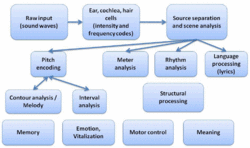Template:Featured Article/doc: Difference between revisions
imported>Caesar Schinas mNo edit summary |
imported>Daniel Mietchen m (Halobacterium NRC-1 is not transcluded any more) |
||
| Line 11: | Line 11: | ||
=== Example === | === Example === | ||
The following code gives the result displayed below the line:<br /> | The following code gives the result displayed below the line:<br /> | ||
<code><nowiki>{{Featured Article| | <code><nowiki>{{Featured Article|Music perception}}</nowiki></code> | ||
---- | ---- | ||
{{Featured Article| | {{Featured Article|Music perception}} | ||
Revision as of 14:58, 19 June 2009
This template is for displaying the Article of the Week and New Draft of the Week on the home page.
Prior to an article being featured, it will be shown in the list of candidates using {{Featured Article Candidate}}.
Usage
Certain changes must be made to candidate articles before they can be featured.
These changes should be made well before an article is featured, and are listed on the {{Featured Article Candidate}} page.
Once a candidate article becomes a wining featured article, the code below should be placed in the Current Winner section of the Article of the Week or New Draft of the Week page:
<onlyinclude>{{Featured Article|Article Name}}</onlyinclude>
Example
The following code gives the result displayed below the line:
{{Featured Article|Music perception}}
Processing a highly structured and complex pattern of sensory input as a unified percept of "music" is probably one of the most elaborate features of the human brain. In recent years, attempts have been made to investigate the neural substrates of music perception in the brain. Though progress has been made with the use of rather simplified musical stimuli, understanding how music is perceived and how it may elicit intense sensations is far from being understood.
Theoretical models of music perception are facing the big challenge to explain a vast variety of different aspects which are connected to music, ranging from temporal pattern analysis such as metre and rhythm analysis, over syntactic analysis, as for example processing of harmonic sequences, to more abstract concepts like semantics of music and interplay between listeners' expectations and suspense. It was tried to give some of these aspects a neural foundation which will be discussed below.
Several authors have proposed a modular framework for music perception [1][2]. After Fodor, mental "modules" have to fulfil certain conditions, among the most important ones of which are the concepts of information encapsulation and domain-specificity. Information encapsulation means that a (neural) system is performing a specific information-processing task and is doing so independent of the activities of other modules. Domain-specificity means that the module is reacting only to specific aspects of a sensory modality. Fodor defines further conditions for a mental module like rapidity of operation, automaticity, neural specificity and innateness that have been debated with respect to the validity for music-processing modules.
However, there is evidence from various complementary approaches that music is processed independently from e.g. language and that there is not even a single module for music itself, but rather sub-systems for different relevant tasks. Evidence for spatial modularity comes mainly from brain lesion studies where patients show selective neurological impairments. Peretz and colleagues list several cases in a meta-study in which patients were not able to recognize musical tunes but were completely unaffected in recognizing spoken language[2]. Such "amusia" can be innate or acquired, for example after a stroke. On the other hand, there are cases of verbal agnosia where the patients can still recognize tunes and seem to have an unaffected sensation of music. Brain lesion studies also revealed selective impairments for more specialized tasks such as rhythm detection or harmonical judgements.
The idea of modularity has also been strongly supported by the use of modern brain-imaging techniques like PET and fMRI. In these studies, participants usually perform music-related tasks (detecting changes in rhythm or out-of-key notes). The obtained brain activations are then compared to a reference task, so one is able to detect brain regions which were especially active for a particular task. Using a similar paradigm, Platel and colleagues have found distinct brain regions for semantic, pitch, rhythm and timbre processing [3] .
To find out the dependencies between different neural modules, brain imaging techniques with a high temporal resolution are usually used. These are e.g. EEG and MEG which can reveal the delay between stimulus onset and the processing of specific features. These studies showed for example that pitch height is detected within 10-100 ms after stimulus onset, while irregularities in harmonic sequences elicit an enhanced brain response 200 ms after stimulus presentation[1]. Another method to investigate the information flow between the modules in the brain is TMS. In principle, also DTI or fMRI observations with causality analysis can reveal those interdependencies. (Read more...)
- ↑ 1.0 1.1 Koelsch, S.; Siebel, W.A. (2005). "Towards a neural basis of music perception". Trends in Cognitive Sciences 9 (12): 578-584. DOI:10.1016/j.tics.2005.10.001. Research Blogging.
- ↑ 2.0 2.1 Peretz, I.; Coltheart, M. (2003). "Modularity of music processing.". Nat Neurosci 6 (7): 688-91. DOI:10.1038/nn1083. Research Blogging.
- ↑ Platel, H.; Price, C.; Baron, J.C.; Wise, R.; Lambert, J.; Frackowiak, R.S.; Lechevalier, B.; Eustache, F. (1997). "The structural components of music perception. A functional anatomical study". Brain 120 (2): 229-243. DOI:10.1093/brain/120.2.229. Research Blogging.
